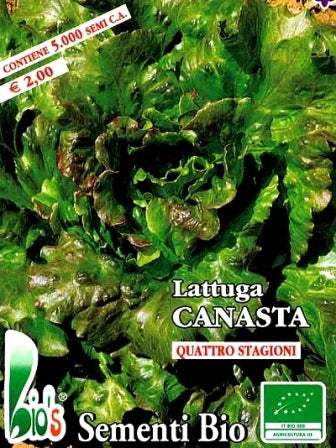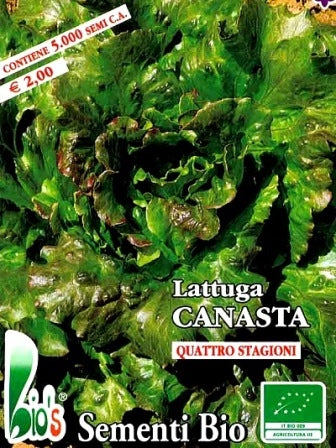Brief history and botanical notes on the plant
Lettuce owes its name to the whitish juice, the lactucarium, which comes out from the fracture of the leaves, stem and roots from the Latin lac, lactis (milk). It is an annual species, the root system is composed of a short taproot and thin, fleshy superficial roots that explore the first 20-30 cm of depth. The basal leaves are of various shapes, ovate or elongated, green or reddish in color; they form a more or less compact lump or "head". At the end of the vegetative phase it emits the floral scape, 100–150 cm high, very branched, bearing numerous inflorescences of 8-10 hermaphroditic, ligulate and yellow flowers, gathered in a flower head; the fruits (mistakenly called seeds) are oblong, flattened, slightly streaked achenes, varying in color from gray to brown (1,000 seeds weigh 1.1-1.2 grams). The origins of the cultivation of lettuce are lost in the past, according to some authors its origin is to be found in the distant lands of Siberia, however this vegetable was already known to the ancient Egyptians, while the Romans developed its diffusion throughout the West, attributing it various therapeutic virtues. 
Family and variety
Lettuce is part of the Composite family (scientific name: Lactuca sativa). The name comes from the flower composed of many small flowers.
There are many varieties of lettuce. The head lettuces (Appia, Battavia blonde with red edge, Wonder of the four seasons, Queen of ice, Trocadero etc.) are also called ball lettuces and can be found on the market throughout the year. Romaine lettuces (Bionda degli ortolani, Verde d'inverno, Mortadella verde d'inverto etc.) with wider, non-overlapping leaves and cutting lettuces also known as "Lattughino" with leaves always spread apart.
Pedoclimatic needs
Lettuces stop their growth at temperatures below 6°C, but can tolerate frosts down to -2°C for a short period.
Sowing and transplanting times
Sowing should be carried out in a seedbed 30-50 days before transplanting and seedlings with 2-3 leaves in spring-summer or with 3-4 leaves in autumn will be used. A distance of 30-40 cm must be maintained between the rows, while 20-30 cm between the plants. The distances will vary in consideration of the management of the weeds and therefore of the machinery/tools available on the farm or of any mulching such as nylon, non-woven fabric. fabric, straw, etc…
Fertilizations
Lettuces have low needs for N and P, medium needs for K, they really love fertile soils rich in organic substance and crops are advantaged by the use of compost or mature manure.
Crop care and irrigation
It is important to maintain an adequate amount of soil humidity (not excesses or stagnation), especially during the transplanting phase and during the summer and late autumn periods. Lettuces require repeated irrigation on a daily basis during the summer period, we recommend watering in the evening or early morning to avoid sunburn, rot or attracting slugs. Drought conditions favor the emergence of seeds in plants.
Adversity
Aphids: small insects that steal sap from affected plants, have a high reproductive capacity and are able to appear in large colonies on the leaves. Particular attention must be paid to the period of initiation of cultivation, as young plants, if affected by a strong outbreak of aphids, may suffer from viral pathologies carried by them. There are numerous useful insects capable of controlling the onset of an attack, especially the larvae of hoverflies and ladybugs are strong predators of aphids (the latter up to 100-150 per day).
Treatments with Marseille soaps (suffocating effect) or alcohol and numerous macerates (in particular garlic and onion which have a strong and immediate repellent effect) allow good control over aphids.
Generally, if the attacks are repeated over time, the incorrect management of N quantities can probably be the trigger for the attacks (primarily under-mature compost and manure).
Rot: fungal diseases that occur both at the beginning and close to harvesting. They can cause the total destruction of plants.
The onset of these pathologies is to be found in an imbalance of bacteria and fungi present in the soil, this can also be caused by prolonged periods of rain and by soils with "difficult" structures, in this case biodynamic agriculture recommends the use of Equisetum arvense to bring the fungi that try to climb back to the soil surface back into depth. Even transplanting with the collar placed superficially, large planting spaces, balanced fertilization, careful irrigation with non-cold water help to avoid the onset of harmful fungi.
Production and collection
Lettuces allow variable harvests depending on the periods (open field or greenhouse), the annual cycles that can be carried out and the varieties considered. It goes from 150-200 q ha for hood lettuces up to 250-350 for romaine lettuces. In one m2 the yield is approximately 2-3 kg.
Nutritional values
Lactucarium, the milky liquid contained in lettuce, has mild sedative properties (decongestant and anti-hypertensive powers).
Lettuce has a high content of vitamins A, B and, in some varieties, also vitamin C, while potassium, calcium and iron make up the list of mineral salts. Excellent fiber content and digestibility. It has less than 20 calories contained in 100 g of product.
Biodynamics
Sowing and harvesting on leaf days, we recommend giving a little mature compost, spraying cornolet manure to activate the vital forces of the soil and proceed with transplanting (it is also possible to bathe the roots to encourage rooting).
If the soil has previously been sufficiently aerated (for example, a passage with a toothed harrow at 10-15 cm is sufficient) there will be no water stagnation which can cause fungal attacks.
Furthermore, the mature compost, even if only as a small layer, is a real "living" skin that we give to our soil, it will help regulate water supplies (thanks to the presence of humus) while the "good" microorganisms will keep the various possible pathogens such as rot.



